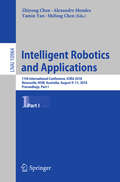 Intelligent Robotics and Applications: 11th International Conference, Icira 2018, Newcastle, Nsw, Australia, August 9-11, 2018, Proceedings, Part Ii (Lecture Notes in Computer Science #10985)
2134126
Intelligent Robotics and Applications: 11th International Conference, Icira 2018, Newcastle, Nsw, Australia, August 9-11, 2018, Proceedings, Part Ii (Lecture Notes in Computer Science #10985)
2134126
|
Zhiyong Chen
Alexandre Mendes
Yamin Yan
Shifeng Chen
|
9783319975863 |
2018 |
Contains images
|
|
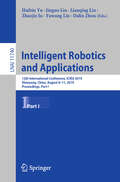 Intelligent Robotics and Applications: 12th International Conference, ICIRA 2019, Shenyang, China, August 8–11, 2019, Proceedings, Part I (Lecture Notes in Computer Science #11740)
2740697
Intelligent Robotics and Applications: 12th International Conference, ICIRA 2019, Shenyang, China, August 8–11, 2019, Proceedings, Part I (Lecture Notes in Computer Science #11740)
2740697
|
Zhaojie Ju
Haibin Yu
Jinguo Liu
Lianqing Liu
Yuwang Liu
Dalin Zhou
|
9783030275266 |
2019 |
Contains images
|
|
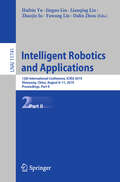 Intelligent Robotics and Applications: 12th International Conference, ICIRA 2019, Shenyang, China, August 8–11, 2019, Proceedings, Part II (Lecture Notes in Computer Science #11741)
2740698
Intelligent Robotics and Applications: 12th International Conference, ICIRA 2019, Shenyang, China, August 8–11, 2019, Proceedings, Part II (Lecture Notes in Computer Science #11741)
2740698
|
Zhaojie Ju
Haibin Yu
Jinguo Liu
Lianqing Liu
Yuwang Liu
Dalin Zhou
|
9783030275327 |
2019 |
Contains images
|
|
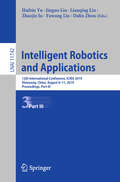 Intelligent Robotics and Applications: 12th International Conference, ICIRA 2019, Shenyang, China, August 8–11, 2019, Proceedings, Part III (Lecture Notes in Computer Science #11742)
2740699
Intelligent Robotics and Applications: 12th International Conference, ICIRA 2019, Shenyang, China, August 8–11, 2019, Proceedings, Part III (Lecture Notes in Computer Science #11742)
2740699
|
Zhaojie Ju
Haibin Yu
Jinguo Liu
Lianqing Liu
Yuwang Liu
Dalin Zhou
|
9783030275358 |
2019 |
Contains images
|
|
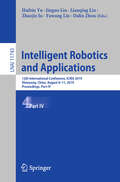 Intelligent Robotics and Applications: 12th International Conference, ICIRA 2019, Shenyang, China, August 8–11, 2019, Proceedings, Part IV (Lecture Notes in Computer Science #11743)
2740700
Intelligent Robotics and Applications: 12th International Conference, ICIRA 2019, Shenyang, China, August 8–11, 2019, Proceedings, Part IV (Lecture Notes in Computer Science #11743)
2740700
|
Zhaojie Ju
Haibin Yu
Jinguo Liu
Lianqing Liu
Yuwang Liu
Dalin Zhou
|
9783030275389 |
2019 |
Contains images
|
|
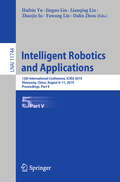 Intelligent Robotics and Applications: 12th International Conference, ICIRA 2019, Shenyang, China, August 8–11, 2019, Proceedings, Part V (Lecture Notes in Computer Science #11744)
2743180
Intelligent Robotics and Applications: 12th International Conference, ICIRA 2019, Shenyang, China, August 8–11, 2019, Proceedings, Part V (Lecture Notes in Computer Science #11744)
2743180
|
Zhaojie Ju
Haibin Yu
Jinguo Liu
Lianqing Liu
Yuwang Liu
Dalin Zhou
|
9783030275419 |
2019 |
Contains images
|
|
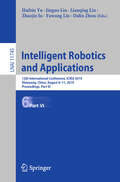 Intelligent Robotics and Applications: 12th International Conference, ICIRA 2019, Shenyang, China, August 8–11, 2019, Proceedings, Part VI (Lecture Notes in Computer Science #11745)
2743179
Intelligent Robotics and Applications: 12th International Conference, ICIRA 2019, Shenyang, China, August 8–11, 2019, Proceedings, Part VI (Lecture Notes in Computer Science #11745)
2743179
|
Zhaojie Ju
Haibin Yu
Jinguo Liu
Lianqing Liu
Yuwang Liu
Dalin Zhou
|
9783030275297 |
2019 |
Contains images
|
|
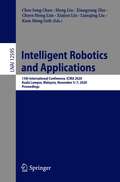 Intelligent Robotics and Applications: 13th International Conference, ICIRA 2020, Kuala Lumpur, Malaysia, November 5–7, 2020, Proceedings (Lecture Notes in Computer Science #12595)
3776477
Intelligent Robotics and Applications: 13th International Conference, ICIRA 2020, Kuala Lumpur, Malaysia, November 5–7, 2020, Proceedings (Lecture Notes in Computer Science #12595)
3776477
|
Hong Liu
Chee Seng Chan
Lianqing Liu
Xiangyang Zhu
Chern Hong Lim
Xinjun Liu
Kam Meng Goh
|
9783030666453 |
2020 |
Contains images
|
|
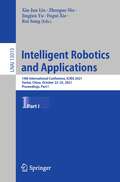 Intelligent Robotics and Applications: 14th International Conference, ICIRA 2021, Yantai, China, October 22–25, 2021, Proceedings, Part I (Lecture Notes in Computer Science #13013)
4328903
Intelligent Robotics and Applications: 14th International Conference, ICIRA 2021, Yantai, China, October 22–25, 2021, Proceedings, Part I (Lecture Notes in Computer Science #13013)
4328903
|
Xin-Jun Liu
Zhenguo Nie
Jingjun Yu
Fugui Xie
Rui Song
|
9783030890957 |
2021 |
Contains images
|
|
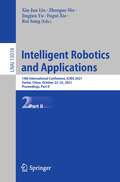 Intelligent Robotics and Applications: 14th International Conference, ICIRA 2021, Yantai, China, October 22–25, 2021, Proceedings, Part II (Lecture Notes in Computer Science #13014)
4296271
Intelligent Robotics and Applications: 14th International Conference, ICIRA 2021, Yantai, China, October 22–25, 2021, Proceedings, Part II (Lecture Notes in Computer Science #13014)
4296271
|
Xin-Jun Liu
Zhenguo Nie
Jingjun Yu
Fugui Xie
Rui Song
|
9783030890988 |
2021 |
Contains images
|
|
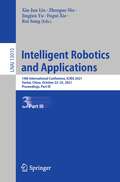 Intelligent Robotics and Applications: 14th International Conference, ICIRA 2021, Yantai, China, October 22–25, 2021, Proceedings, Part III (Lecture Notes in Computer Science #13015)
4327441
Intelligent Robotics and Applications: 14th International Conference, ICIRA 2021, Yantai, China, October 22–25, 2021, Proceedings, Part III (Lecture Notes in Computer Science #13015)
4327441
|
Xin-Jun Liu
Zhenguo Nie
Jingjun Yu
Fugui Xie
Rui Song
|
9783030891343 |
2021 |
Contains images
|
|
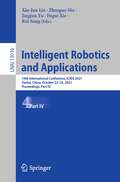 Intelligent Robotics and Applications: 14th International Conference, ICIRA 2021, Yantai, China, October 22–25, 2021, Proceedings, Part IV (Lecture Notes in Computer Science #13016)
4330013
Intelligent Robotics and Applications: 14th International Conference, ICIRA 2021, Yantai, China, October 22–25, 2021, Proceedings, Part IV (Lecture Notes in Computer Science #13016)
4330013
|
Xin-Jun Liu
Zhenguo Nie
Jingjun Yu
Fugui Xie
Rui Song
|
9783030890926 |
2021 |
Contains images
|
|
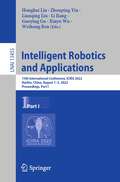 Intelligent Robotics and Applications: 15th International Conference, ICIRA 2022, Harbin, China, August 1–3, 2022, Proceedings, Part I (Lecture Notes in Computer Science #13455)
4780005
Intelligent Robotics and Applications: 15th International Conference, ICIRA 2022, Harbin, China, August 1–3, 2022, Proceedings, Part I (Lecture Notes in Computer Science #13455)
4780005
|
Honghai Liu
Li Jiang
Zhouping Yin
Lianqing Liu
Xinyu Wu
Guoying Gu
Weihong Ren
|
9783031138447 |
2022 |
Contains images
|
|
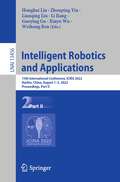 Intelligent Robotics and Applications: 15th International Conference, ICIRA 2022, Harbin, China, August 1–3, 2022, Proceedings, Part II (Lecture Notes in Computer Science #13456)
4780007
Intelligent Robotics and Applications: 15th International Conference, ICIRA 2022, Harbin, China, August 1–3, 2022, Proceedings, Part II (Lecture Notes in Computer Science #13456)
4780007
|
Honghai Liu
Li Jiang
Zhouping Yin
Lianqing Liu
Xinyu Wu
Guoying Gu
Weihong Ren
|
9783031138225 |
2022 |
Contains images
|
|
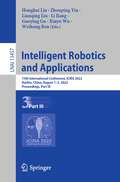 Intelligent Robotics and Applications: 15th International Conference, ICIRA 2022, Harbin, China, August 1–3, 2022, Proceedings, Part III (Lecture Notes in Computer Science #13457)
4780006
Intelligent Robotics and Applications: 15th International Conference, ICIRA 2022, Harbin, China, August 1–3, 2022, Proceedings, Part III (Lecture Notes in Computer Science #13457)
4780006
|
Honghai Liu
Li Jiang
Zhouping Yin
Lianqing Liu
Xinyu Wu
Guoying Gu
Weihong Ren
|
9783031138355 |
2022 |
Contains images
|
|
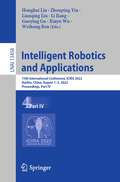 Intelligent Robotics and Applications: 15th International Conference, ICIRA 2022, Harbin, China, August 1–3, 2022, Proceedings, Part IV (Lecture Notes in Computer Science #13458)
4780008
Intelligent Robotics and Applications: 15th International Conference, ICIRA 2022, Harbin, China, August 1–3, 2022, Proceedings, Part IV (Lecture Notes in Computer Science #13458)
4780008
|
Honghai Liu
Li Jiang
Zhouping Yin
Lianqing Liu
Xinyu Wu
Guoying Gu
Weihong Ren
|
9783031138416 |
2022 |
Contains images
|
|
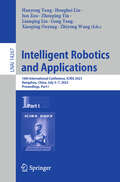 Intelligent Robotics and Applications: 16th International Conference, ICIRA 2023, Hangzhou, China, July 5–7, 2023, Proceedings, Part I (Lecture Notes in Computer Science #14267)
6504669
Intelligent Robotics and Applications: 16th International Conference, ICIRA 2023, Hangzhou, China, July 5–7, 2023, Proceedings, Part I (Lecture Notes in Computer Science #14267)
6504669
|
Honghai Liu
Zhouping Yin
Huayong Yang
Lianqing Liu
Geng Yang
Jun Zou
Xiaoping Ouyang
Zhiyong Wang
|
9789819964833 |
2023 |
Contains images
|
|
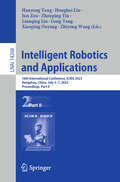 Intelligent Robotics and Applications: 16th International Conference, ICIRA 2023, Hangzhou, China, July 5–7, 2023, Proceedings, Part II (Lecture Notes in Computer Science #14268)
6419791
Intelligent Robotics and Applications: 16th International Conference, ICIRA 2023, Hangzhou, China, July 5–7, 2023, Proceedings, Part II (Lecture Notes in Computer Science #14268)
6419791
|
Honghai Liu
Zhouping Yin
Huayong Yang
Lianqing Liu
Geng Yang
Jun Zou
Xiaoping Ouyang
Zhiyong Wang
|
9789819964864 |
2023 |
Contains images
|
|
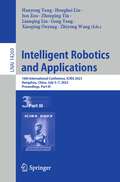 Intelligent Robotics and Applications: 16th International Conference, ICIRA 2023, Hangzhou, China, July 5–7, 2023, Proceedings, Part III (Lecture Notes in Computer Science #14269)
5718132
Intelligent Robotics and Applications: 16th International Conference, ICIRA 2023, Hangzhou, China, July 5–7, 2023, Proceedings, Part III (Lecture Notes in Computer Science #14269)
5718132
|
Honghai Liu
Zhouping Yin
Huayong Yang
Lianqing Liu
Geng Yang
Jun Zou
Xiaoping Ouyang
Zhiyong Wang
|
9789819964895 |
2023 |
Contains images
|
|
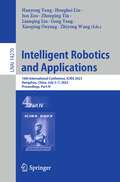 Intelligent Robotics and Applications: 16th International Conference, ICIRA 2023, Hangzhou, China, July 5–7, 2023, Proceedings, Part IV (Lecture Notes in Computer Science #14270)
5724176
Intelligent Robotics and Applications: 16th International Conference, ICIRA 2023, Hangzhou, China, July 5–7, 2023, Proceedings, Part IV (Lecture Notes in Computer Science #14270)
5724176
|
Honghai Liu
Zhouping Yin
Huayong Yang
Lianqing Liu
Geng Yang
Jun Zou
Xiaoping Ouyang
Zhiyong Wang
|
9789819964925 |
2023 |
Contains images
|
|
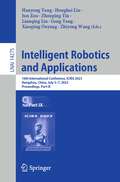 Intelligent Robotics and Applications: 16th International Conference, ICIRA 2023, Hangzhou, China, July 5–7, 2023, Proceedings, Part IX (Lecture Notes in Computer Science #14275)
5719517
Intelligent Robotics and Applications: 16th International Conference, ICIRA 2023, Hangzhou, China, July 5–7, 2023, Proceedings, Part IX (Lecture Notes in Computer Science #14275)
5719517
|
Honghai Liu
Zhouping Yin
Huayong Yang
Lianqing Liu
Geng Yang
Jun Zou
Xiaoping Ouyang
Zhiyong Wang
|
9789819965045 |
2023 |
Contains images
|
|
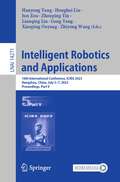 Intelligent Robotics and Applications: 16th International Conference, ICIRA 2023, Hangzhou, China, July 5–7, 2023, Proceedings, Part V (Lecture Notes in Computer Science #14271)
5724177
Intelligent Robotics and Applications: 16th International Conference, ICIRA 2023, Hangzhou, China, July 5–7, 2023, Proceedings, Part V (Lecture Notes in Computer Science #14271)
5724177
|
Honghai Liu
Zhouping Yin
Huayong Yang
Lianqing Liu
Geng Yang
Jun Zou
Xiaoping Ouyang
Zhiyong Wang
|
9789819964956 |
2023 |
Contains images
|
|
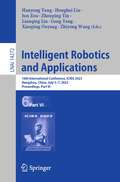 Intelligent Robotics and Applications: 16th International Conference, ICIRA 2023, Hangzhou, China, July 5–7, 2023, Proceedings, Part VI (Lecture Notes in Computer Science #14272)
5710426
Intelligent Robotics and Applications: 16th International Conference, ICIRA 2023, Hangzhou, China, July 5–7, 2023, Proceedings, Part VI (Lecture Notes in Computer Science #14272)
5710426
|
Honghai Liu
Zhouping Yin
Huayong Yang
Lianqing Liu
Geng Yang
Jun Zou
Xiaoping Ouyang
Zhiyong Wang
|
9789819964802 |
2023 |
Contains images
|
|
 Intelligent Robotics and Applications: 16th International Conference, ICIRA 2023, Hangzhou, China, July 5–7, 2023, Proceedings, Part VII (Lecture Notes in Computer Science #14273)
6426612
Intelligent Robotics and Applications: 16th International Conference, ICIRA 2023, Hangzhou, China, July 5–7, 2023, Proceedings, Part VII (Lecture Notes in Computer Science #14273)
6426612
|
Honghai Liu
Zhouping Yin
Huayong Yang
Lianqing Liu
Geng Yang
Jun Zou
Xiaoping Ouyang
Zhiyong Wang
|
9789819964987 |
2023 |
Contains images
|
|
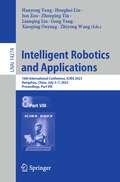 Intelligent Robotics and Applications: 16th International Conference, ICIRA 2023, Hangzhou, China, July 5–7, 2023, Proceedings, Part VIII (Lecture Notes in Computer Science #14274)
5719494
Intelligent Robotics and Applications: 16th International Conference, ICIRA 2023, Hangzhou, China, July 5–7, 2023, Proceedings, Part VIII (Lecture Notes in Computer Science #14274)
5719494
|
Honghai Liu
Zhouping Yin
Huayong Yang
Lianqing Liu
Geng Yang
Jun Zou
Xiaoping Ouyang
Zhiyong Wang
|
9789819965014 |
2023 |
Contains images
|
|